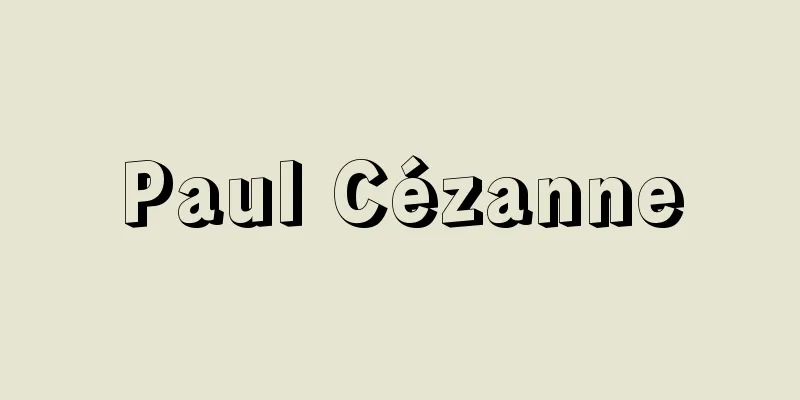Paul Cézanne

|
A French painter, he is considered one of the great masters of modern art history. He was born on January 19th to a wealthy family in Aix-en-Provence, southern France. Since his childhood, he had been friends with Emile Zola. At his father's request, he went to law school in Aix, but decided to become a painter again and went to Paris for the first time in 1861. The period from then on was the early period. During this time, he failed the entrance exam to art school, and attended the private art school, the Academie Suisse, where he learned about Pissarro and Guillaumin, and eventually came into contact with Monet and Renoir. Through this friendship, he was awakened to the innovative tendencies of anti-official artists such as Delacroix, Courbet, and Manet, and painted thick, heavy-looking still lifes and portraits. His most notable works are "Still Life with a Black Marble Clock" and "Portrait of Achille Ampreur." Cézanne, who spent the turbulent period of the Prussian-French War and the Paris Commune in the fishing village of Estaque near Marseille, resumed his friendship with Pissarro in the autumn of 1871, and learned the principles of Impressionism while working in Auber and Pontoise. His friendship with Paul Ferdinand Gachet (1828-1909), a doctor in Auber, was also important. He exhibited three works, including his masterpiece The Hanging House, at the first Impressionist exhibition in 1874, and 16 works, including Portrait of Choquet, at the third exhibition in 1877, becoming one of the core members of the Impressionist movement. Compared to his early works, the paintings are smaller but brighter, the brushstrokes are smaller and more carefully applied, and sometimes the color tones are divided carefully. Other notable changes include the appearance of bathing scenes instead of literary themes, and a calmer and more objective vision. Cézanne no longer participates in Impressionist exhibitions after this. This was due to the negative public reactions to his two previous exhibitions and criticism from within the Impressionist movement regarding his submission to the Salon. Rather, he wanted to use his rich experience of Impressionism as a foundation to establish an art form that was "more solid and more permanent than the arts in museums." This effort was undertaken head-on in the 1880s. From around 1880 onwards, he produced more self-portraits and portraits of his wife. He also produced a series of bathing scenes, with men and women depicted in separate compositions, and his still lifes, such as "Blue Vase," are notable for their beautiful colors, the variety of materials, and the ingenious composition. His series of works, such as "The Sea at L'Estaque" and "Mont Sainte-Victoire with Pine Trees," are also works that beautifully capture the bright, generous, vast space of southern France without sacrificing either flatness or depth. Around this time, Cézanne continued to work, commuting between Paris and Aix, as he did in his early years. The year 1886 was an important one, with the publication of Zola's novel "Composition," which ended their friendship, his official marriage to his wife Hortence Fiquet (1850-1922), and the death of his father. Although he occasionally met with fellow Impressionists, he never exhibited his work, so he was gradually forgotten by the public, and only a few people were able to see his works at the shop of Julien Tanguy (1825-1994). However, through this shop, Cézanne's influence first reached Gauguin, E. Bernard, and then the Nabis. From 1890 onwards, he produced a succession of masterpieces, including the series Boy in a Red Vest and The Card Players, as well as Madame Cézanne in a Conservatory. At the end of 1895, the art dealer Ambroise Vollard (1866-1939) held a Cézanne exhibition in Paris, which astonished young artists of the time. Cézanne's art, which was inspired by the Impressionists but far more intellectual and full of fresh wildness, was becoming known to the world for the first time, and even Pissarro and Degas were deeply moved. Around this time, Cézanne began to produce many watercolors. Due to the ease of production and the transparency of the colors, the effect of watercolor techniques also appeared in oil paintings. The paint was applied thinly, and the thin layers of paint overlapped in a complex way, creating a glittering diamond-cut effect. In both oil and watercolor paintings, there is a lot of white space left unpainted, but even this white space has a kind of expressive power and is effective. This technique, which can be seen in many of his later works, combined with his compositional ingenuity in looking at the shape of an object from multiple perspectives, had a huge influence on Cubism and abstract art. It is no exaggeration to say that 20th century art owes more to Cezanne than it does to Van Gogh, Gauguin, or Seurat. In 1901, he built a studio in Louves, on the outskirts of Aix, and his fame and visitor numbers increased, but on October 15, 1906, while working outdoors, he collapsed in a thunderstorm and died on the 22nd. Today, Cézanne's works are collected and displayed in museums around the world, including the Metropolitan Museum of Art in New York and the Musée d'Orsay in Paris, and in Japan, more than a dozen of his works are on display in Tokyo, Kurashiki, Hiroshima, and other cities. [Tadashi Ikegami] "The Letters of Cezanne" edited by John Rewald and translated by Ikegami Chuji (1982, Bijutsu Koronsha) " ▽ "25 Painters of Cezanne" commented by Watanabe Yasuko (1980/New edition, 1995, Kodansha)" ▽ "Cezanne" by Henri Perruchot, translated by Yanaihara Isaku (1963/New edition, 1995, Misuzu Shobo)" [References] | | | [Chronology] |Circa 1890 Oil painting , Metropolitan Museum of Art Cezanne's "Pot of Apples and Primroses..." 1874-1875 Oil painting , Metropolitan Museum of Art Cezanne "Bathers" Circa 1885 Oil painting , Metropolitan Museum of Art Cezanne: Marseilles Viewed from the Pier... 1902-1906 Oil painting, Metropolitan Museum of Art Cezanne's "Mont Sainte-Victoire" 1890-1892 Oil painting , Metropolitan Museum of Art Cezanne "Playing Cards" 1891 Oil painting , Metropolitan Museum of Art Cezanne, Madame Cezanne in the Conservatory Circa 1893 Oil painting , owned by the Art Institute of Chicago Cezanne's "Basket of Apples" Source: Shogakukan Encyclopedia Nipponica About Encyclopedia Nipponica Information | Legend |
|
フランスの画家で、近代美術史上の巨匠の一人と目される。南フランス、エクサン・プロバンスの富裕な家庭に1月19日に生まれる。少年時代以後、ずっとエミール・ゾラと交友があった。父の希望でエクスの法科大学に進むが、改めて画家となる決意をし、1861年初めてパリに出る。以後のほぼ10年間が初期にあたる。この間に美術学校の入試に失敗、民間の画塾アカデミー・スイスに通ってピサロやギヨーマンを知り、やがてモネやルノワールとも交わる。この交友のなかでドラクロワ、クールベ、マネなど反官展的な立場の革新的な傾向に開眼し、厚くて重苦しいマチエールの静物画、肖像画などを描く。『黒大理石の置時計のある静物』や『アシル・アンプレールの肖像』が代表的である。 プロイセン・フランス戦争とパリ・コミューンの動乱期をマルセイユに近い漁村エスタックで過ごしたセザンヌは、1871年秋以降ピサロとの交友を復活、オベールやポントワーズで制作しながら印象主義の原則を教わる。オベールの医師ガッシェPaul Ferdinand Gachet(1828―1909)との友情も重要である。1874年第1回印象派展に当時の力作『首つりの家』など3点、1877年の第3回展に『ショケ像』など16点を出品して、印象派の中核的なメンバーの一人となる。初期作品と比較して画面はより小さく、しかしより明るくなり、筆触も小さくていねいに与えられ、ときには入念な色調分割も行われる。文学的な主題にかわって水浴図が登場したこと、視覚が冷静かつ客観的なものになったことも注目すべき変化である。以後セザンヌは印象派展に参加しなくなる。二度の出品に対する世評が芳しくなかったのと、サロン応募に関して印象派内部からの批判があったためである。むしろ彼は豊かな印象主義体験を基礎として「美術館の諸芸術のようにより堅固でより永続的な」芸術を樹立しようと考える。その努力が正面きって展開されるのが1880年代のことである。 1880年ごろ以降、自画像と夫人像が多くなる。水浴図も男女別々の構図で継続的に描かれ、『青い花瓶』に代表される静物画も色彩の美しさ、マチエールの変化、構図上のくふうなどの点で注目に値する。『エスタックの海』『松の木のあるサント・ビクトワール山』などの連作も、南フランスの明るくおおらかな大空間を平面性と奥行とのいずれをも犠牲にすることなく、みごとに把握した作品群である。この前後セザンヌは初期と同じくパリとエクスを往復しながら制作を続ける。1886年は、ゾラの小説『制作』の発表による二人の友情の終わり、妻オルタンスHortence Fiquet(1850―1922)との正式な結婚、父の死などによって重要な年である。ときに印象派の仲間たちと会いはするが、まったく作品を公表しないので、世間からはしだいに忘れられ、若干の人々だけが作品をタンギー爺(じい)さんJulien Tanguy(1825―1994)の店で見ることができた。だが、この店を通じて、セザンヌの影響はまずゴーギャン、E・ベルナール、そしてナビ派へと及んでゆく。 1890年から数年の間に『赤いチョッキの少年』や『トランプをする人びと』などの連作、『温室のセザンヌ夫人』といった名作が次々と描かれる。1895年末に画商のボラールAmbroise Vollard(1866―1939)がパリで開いたセザンヌ展は当時の若い画家たちを驚倒させた。印象派に発しながらもっとはるかに知的で、しかも新鮮な野性味あふれるセザンヌ芸術が初めて世に知られ始め、ピサロやドガなども感動を抑えきれないほどであった。この前後からセザンヌは水彩画を多作するようになる。制作が簡便なためと色彩の透明感のせいで、さらに水彩の技法の作用が油絵にも現れるようになる。絵の具は薄くのばして塗られ、薄い絵の具の層が複雑に重なり合ってきらきらと輝くダイヤモンド・カットのような効果をみせる。油絵でも水彩でも塗り残しの余白が多くなるが、その余白さえ一種の表現力をもって有効に働く。晩年の作品の多くにみられるこの技法は、物の形を複数の視点からみる構図上のくふうと相まって、キュビスムや抽象美術などに甚大な影響を及ぼした。20世紀美術はゴッホやゴーギャン、スーラらから受ける以上に、セザンヌに多くの不可欠のものを負っているといっても過言ではない。1901年、エクス郊外のローブにアトリエを建て、名声もあがり訪問者も増えたが、1906年10月15日、戸外で制作中に雷雨にあって昏倒(こんとう)、22日に死去した。 今日セザンヌの作品はニューヨークのメトロポリタン美術館やパリのオルセー美術館をはじめとして世界中の美術館に分蔵、陳列されており、日本でも東京、倉敷、広島などで十数点が公開されている。 [池上忠治] 『ジョン・リウォルド編、池上忠治訳『セザンヌの手紙』(1982・美術公論社)』▽『渡辺康子解説『25人の画家 セザンヌ』(1980/新装版・1995・講談社)』▽『アンリ・ペリュショ著、矢内原伊作訳『セザンヌ』(1963/新装版・1995・みすず書房)』 [参照項目] | | | [年表] |1890年ころ 油彩メトロポリタン美術館所蔵"> セザンヌ『リンゴとサクラソウの鉢のある… 1874~1875年 油彩メトロポリタン美術館所蔵"> セザンヌ『水浴図』 1885年ころ 油彩メトロポリタン美術館所蔵"> セザンヌ『エスタックから眺めたマルセイ… 1902~1906年ころ 油彩メトロポリタン美術館所蔵"> セザンヌ『サント・ビクトワール山』 1890~1892年 油彩メトロポリタン美術館所蔵"> セザンヌ『トランプをする人びと』 1891年 油彩メトロポリタン美術館所蔵"> セザンヌ『温室のセザンヌ夫人』 1893年ころ 油彩シカゴ美術研究所所蔵"> セザンヌ『リンゴの籠』 出典 小学館 日本大百科全書(ニッポニカ)日本大百科全書(ニッポニカ)について 情報 | 凡例 |
>>: Sekondi‐Takoradi (English spelling)
Recommend
decalcomania
...When printing on non-flat objects, the method ...
Japanese National Socialist Party
A national socialist party formed during the Manch...
Barrel carpenter - Okedaiku
〘 noun 〙 A carpenter who makes and repairs barrels...
Carnarvon - Carnarvon
…the capital of Gwynedd, northwest Wales, United ...
Alabaster - Arabaster (English spelling)
A sulfate mineral. Also called selenite. A mass o...
International Folk Music Council
In order to foster cooperation among researchers ...
Overtaking sight distance - Oikoshishikyo
Strictly speaking, it is defined as the distance ...
Castle rice magistrate - Jomaibugyo
A title of a job in the Edo Shogunate. One of the ...
Ginzburg, ES - Ginzburg
…He has been actively publishing his avant-garde ...
claw
…In mammals, claws are specialized according to f...
Silken tofu
Tofu is made by placing highly concentrated soy mi...
Ejiri
A place name in Ihara County, Suruga Province. In ...
Ambix
...However, the technology of distillation was di...
Autogamous plant - Self-pollinating plant
Angiosperms that reproduce primarily by self-polli...
micromotion study
…This method aimed to reduce work time by elimina...









